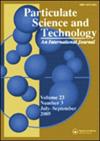伊朗Behshahr黄土和Amol粘土胶结和未经处理的岩土力学研究
IF 1.5
4区 工程技术
Q3 ENGINEERING, CHEMICAL
引用次数: 0
摘要
摘要对于两种粒径大致相同的细粒土,水泥对其岩土性能影响的研究很少。本调查中使用的水泥百分比分别为土壤干重的0、4和8%。压实特性、固结特性、无侧限抗压强度(UCS)和Atterberg极限均在实验室中确定。此外,采用扫描电镜(SEM)对胶结和未处理黄土和粘土的微观结构进行了分析。值得注意的是,在CC = 0%时,黄土和粘土的MDD分别为1.72 gr/cm3和1.57 gr/cm3,在CC = 4%时,MDD分别为1.7 gr/cm3和1.55 gr/cm3。在CC = 0%时,黄土和粘土的OMC分别为15%和22%;在CC = 4%时,OMC分别为17%和20%。CC = 0%时,黄土和粘土黏聚力值分别为25 kPa和28.7 kPa; CC = 8%时,黄土和粘土黏聚力值分别为190 kPa和140 kPa。在CC = 0%时,黄土和粘土的内摩擦度分别为24°和29°;在CC = 8时,其内摩擦度分别为36°和34°。固结试验结果表明,水泥掺量的增加降低了水泥土的压缩性。塑性指数(PI)随水泥浓度的增加而升高。然而,水泥浓度显著降低了塑性指标。此外,水泥剂的加入显著改善了两种土壤的弹性模量和UCS。SEM结果表明,水泥处理后的黄土比水泥处理后的粘土更致密、均一性更好。三轴试验表明,水泥颗粒改善了粘结性和内摩擦角。关键词:水泥、粘土、岩土特性、稳定、黏结、内摩擦角披露声明作者未报告潜在的利益冲突。本文章由计算机程序翻译,如有差异,请以英文原文为准。
Geotechnical studies on cemented and untreated Behshahr loess and Amol clay of Iran
AbstractThere has been little research into the effects of cement on the geotechnical properties of two types of fine-grained soil with roughly the same grain size. The cement percentages used in this investigation were 0, 4, and 8% by dry weight of soil. Compaction features, consolidation characteristics, unconfined compressive strength (UCS), and Atterberg limits were all determined in the laboratory. Furthermore, scanning electron microscopy (SEM) examinations were used to analyze the microstructures of cemented and untreated loess and clay. Notably, the MDD for loess and clay are 1.72 gr/cm3 and 1.57 gr/cm3 at CC = 0%, respectively, and 1.7 gr/cm3 and 1.55 gr/cm3 at CC = 4%. The OMC for loess and clay are 15% and 22% at CC = 0%, respectively, and 17% and 20% at CC = 4%. At CC = 0%, loess and clay have cohesion values of 25 kPa and 28.7 kPa, respectively, and 190 kPa and 140 kPa at CC = 8%. Internal friction degrees for loess and clay are 24 and 29 degrees at CC = 0%, respectively, and 36 and 34 degrees at CC = 8. The consolidation test findings demonstrated that increasing the cement proportion reduced cemented soils’ compressibility. The Plasticity Index (PI) rose as cement concentration increased. However, significant percentages of cement concentration reduced the plasticity index. Furthermore, adding cement agents resulted in significant improvements in elasticity modulus and UCS for both soils. The SEM results indicated that the cement-treated loess was denser and more homogenous than the cement-treated clay sample. Triaxial tests reveal that cement particles improve cohesiveness and internal friction angle.Keywords: Cementloessclaygeotechnical propertiesstabilizationcohesioninternal friction angle Disclosure statementNo potential conflict of interest was reported by the author(s).
求助全文
通过发布文献求助,成功后即可免费获取论文全文。
去求助
来源期刊

Particulate Science and Technology
工程技术-工程:化工
CiteScore
4.40
自引率
4.00%
发文量
86
审稿时长
12 months
期刊介绍:
Particulate Science and Technology, an interdisciplinary journal, publishes papers on both fundamental and applied science and technology related to particles and particle systems in size scales from nanometers to millimeters. The journal''s primary focus is to report emerging technologies and advances in different fields of engineering, energy, biomaterials, and pharmaceutical science involving particles, and to bring institutional researchers closer to professionals in industries.
Particulate Science and Technology invites articles reporting original contributions and review papers, in particular critical reviews, that are relevant and timely to the emerging and growing fields of particle and powder technology.
 求助内容:
求助内容: 应助结果提醒方式:
应助结果提醒方式:


